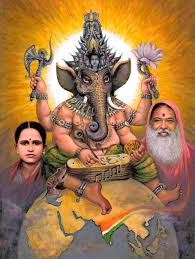Some people pronounce it as ‘Jain’ while some say it is ‘Jina’. Both are same. The only difference is in the ‘Na’ kaara sabda. This ‘Na’ kaara sabda explains the essence of life. Adhering and following it, we should reach ‘Jina’. Realizing or understanding ‘Jivana’ (life’s goal) is only “Jina’.
It is also referred to as Self, Brahma, divine illumination etc. Though it is addressed differently, all the religious practices lead to the same goal i.e. to reach the Supreme Essence that is devoid of form and trait (nirguna).
Guna (traits) originates from nirguna. These traits are responsible for the creation. This is declared in all the Upanishads and Puranas. Upanishads explain the essence of life. They also explain the path to reach the ultimate goal. The paths of devotion (bhakti yoga), rightful action (karma yoga) and Supreme Knowledge (Jnana yoga) originate from them.
All the different religions are nothing but different boats to cross the same river.
We should strictly adhere to the swadharma (own dharma) into which we are born. It is very important. We should do complete justice in obeying God’s decisions.
The great Jina siddha maha purushas (the accomplished saints in the Jina philosophy) led their lives in an exemplary way and through that they taught us the way to lead life. They have shown how to reach God. If we understand the life and history of the great saints we can clearly understand the Self-essence as taught by them.
Vedanta declares that God is formless and traitless. Shankara Bhagavadpadāchārya also preached this. Paramatma is he who has decorated himself with the five elements. It is impossible to describe God. In reality, He resides within us itself. That is why we should not harm ourselves and at the same time we should refrain from harming others. This same philosophy has been preached by the Jain siddhas.
The word jeeva also means Prana (life energy. Through the various techniques like righteous conduct (dharma) penance, japam, practice of yoga and others we are trying to understand about this life-force.
When we approach a Guru or God we join our hands and pray to him. Joining the palms is symbolic of the merger of the individual soul (jeevatma) and the Supreme Soul (Paramatma). We are silently praying, “Please teach us about that Jeevatma Paramatma tattva”.
Sadguru in turn reciprocates by showing the Abhaya mudra (Abhaya means fear-not) with his hand. He is silently replying, ‘Be calm and peaceful. Don’t be over enthusiastic. Don’t misunderstand. Don’t misinterpret. First and foremost surrender your ego. Surrender everything to God (Atmarpana)’.
This universe is nothing but a space provided by the Lord for us to exist. He has given us this life wherein we can complete our old karmas. We had so many past sankalpas (intentions) and past desires to complete which we had to come here and take on this body. Then how can we stay on forever after our works get complete?
It is impossible for any living being to live permanently in this universe. Once our purpose is over we have to leave. Our elders say that we should never seek to live permanently here. It means never desire to be reborn as a human, or to be born in the same city, in the same house and so on. In fact it is a waste to have desires of any form.
When analyzed from this angle, we have not come to stay permanently on this earth. Our stay here is purely temporary. This birth is an opportunity given by God to understand the essence of life (jeevan tattva). One should be careful and not get entangled in these attachments, which are the traps. This birth on earth is a chance to get out of the attachments that we already have created; not to create new ones.
Bhaktimala Jan ‘01
